Release Date :
Reference Number :
Issue No. 3, Series of 2017
Results from the Fisheries Production Survey, 4th Quarter 2016
The overall fisheries production in Region I increased by 0.2 percent in 4th quarter 2016. From the total output of 62,502 metric tons in the same period of 2015, it grew to 62,631 metric tons in 4th quarter 2016. The positive growth in production was contributed by the aquaculture sub-sector. Among the provinces of the region, only Pangasinan posted increase in output by 1.0 percent.
The aquaculture sub-sector contributed 85.2 percent to the total fish production of Region I in 4th quarter 2016. The municipal sub-sector, which comprises the marine and inland municipal fisheries, shared 13.3 percent, while the commercial fisheries accounted 1.5 percent to the total output.
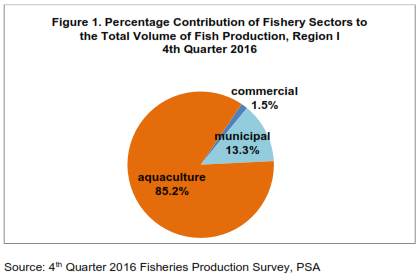
In terms of provincial distribution, the province of Pangasinan shared the bulk of production of about 92.9 percent. Its aquaculture sub-sector registered positive growth, while the commercial and municipal fisheries posted lower production. The total fishery output of the province grew by 1.0 percent from 57,617 metric tons in 4th quarter 2015 to 58,200 metric tons in 4th quarter 2016.
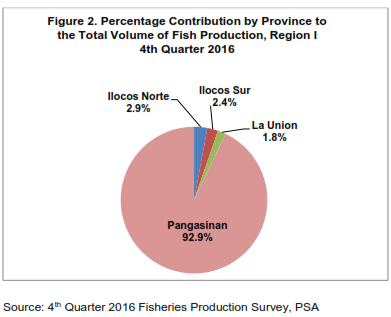
The province of Ilocos Norte registered lower overall fisheries production in 4th quarter 2016 due to the decreased output of both municipal fisheries and aquaculture subsectors. Its total output of 1,828 metric tons was 11.8 percent lower than its output in 4th quarter 2015. Ilocos Norte accounted 2.9 percent to the overall fish production of Region I in 4th quarter 2016.
The fisheries production of Ilocos Sur, which shared 2.4 percent to the total fish production of the region, also registered lower production in 4th quarter 2016. Its production during the period was 1,491 metric tons, lower than the output of 1,500 metric tons recorded in 4th quarter 2015. The aquaculture sub-sector of the province contributed to the decrease in output.
The province of La Union, which shared 1.8 percent to the total fish production of Region I, decreased by 15.2 percent in 4th quarter 2016. Its output during the period was 1,112 metric tons, lower than the output in the same period last year of 1,312 metric tons. The municipal sub-sector contributed to the overall negative growth in the fisheries output of the province.
Table 1. Volume of Fisheries Production by Province and Sector, Region I
4th Quarter 2016 and 4th Quarter 2015

Commercial Fisheries
The commercial fisheries volume of production in Region I declined by 4.8 percent in 4th quarter 2016. Its output was posted at 920 metric tons, lower than the output in the same period last year of 966 metric tons, contributed by the province of Pangasinan. Factors such as decreased fishing days, lesser fishing boats in operation, and stricter implementation of anti-illegal fishing laws may have contributed to the overall negative growth for the sector.
Meanwhile, the provinces of llocos Sur and La Union registered higher output. The positive growth can be attributed to the increased number of fishing days, restored fishing gears, presence of school of fish, and more harvest from payaos.In terms of provincial shares, Pangasinan accounted for 71.1 percent of the region’s commercial fisheries volume of production, followed by La Union with 24.2 percent share, and Ilocos Sur, 4.7 percent share.
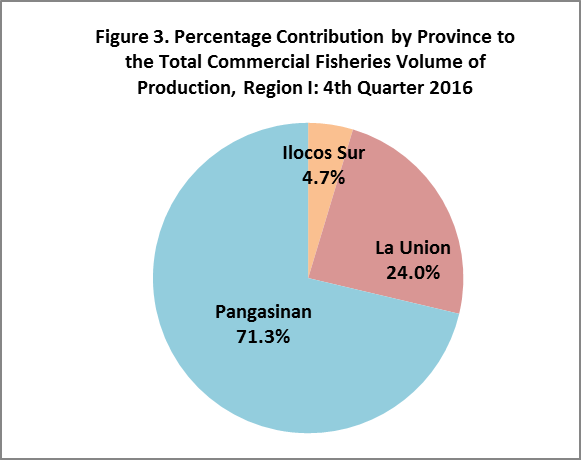
Source: 4th Quarter 2016 Fisheries Production Survey, PSA
The top five major catch in the region during the 4th quarter 2016 were Roundscad,
Skipjack, Yellowfin tuna, Hairtail, and Anchovies.
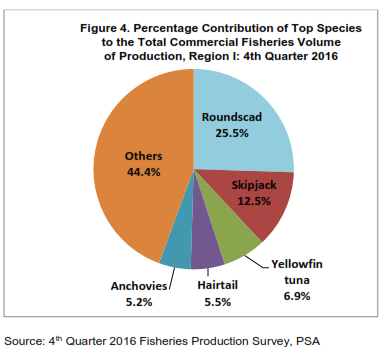
Municipal Fisheries
The overall municipal fisheries production of Region I in 4th quarter of 2016 decreased by
18.9 percent. Overall production was posted at 8,328 metric tons, lower than the output in 4th quarter 2015 of about 10,273 metric tons.
Marine Municipal
Production of Marine Municipal Fisheries in Region I decreased by 20.9 percent in 4th quarter 2016. From its output in the same period of 2015 of 9,787 metric tons, it went down to 7,746 metric tons in 4th quarter 2016. All the provinces in the region, except Ilocos Sur, posted decrement in production. Lesser fishing operations, decreased number of fishing boats, lesser catch from payaos and artificial reefs, and intrusion of commercial fishing vessels and transient fishermen were the factors that could have contributed to the decline in output.
Table 2. Volume of Marine Municipal Fisheries Production by Province, Region I

The province of Pangasinan contributed 56.1 percent of the region’s marine municipal fish catch for the fourth quarter 2016, followed by Ilocos Norte with 22.6 percent share, Ilocos Sur with 15.4 percent share, and La Union with 6.0 percent. The dominant catch in marine municipal water of Region I during the quarter were Yellowfin tuna, Flying fish, Skipjack, Squid, and Cavalla.
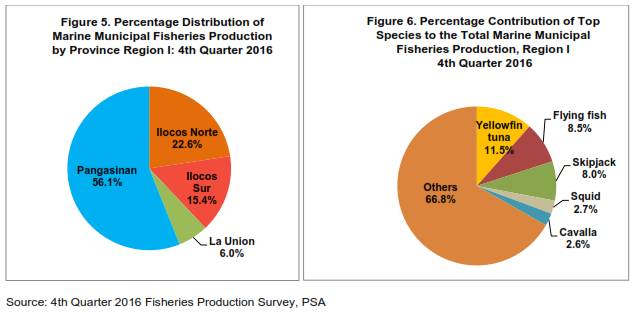
Inland Municipal Fisheries
Production of Inland Municipal Fisheries in Region I increased by 20.1 percent in 4th quarter 2016. Its output during the period was posted at 583 metric tons, higher than the output of 485 metric tons in 4th quarter 2015. All the provinces posted positive output, except Pangasinan. Favorable water level, more frequent operations using gears like spear and hook and line, more catch from overflowed ponds and cages during Typhoon
Lawin, increased number of fish shelters harvested, and continuous dispersal of tilapia fingerlings were the factors that could have contributed to the positive growth in output.
Table 3. Volume of Inland Municipal Fisheries Volume of Production
by Province, Region I: 4th Quarter 2016 and 4th Quarter 2015

By province, La Union ranked first in the volume of production of Inland municipal fisheries during the 4th quarter 2016 with 35.4 percent share. It was followed by Pangasinan with 30.5 percent share, Ilocos Sur with 23.6 percent, and Ilocos Norte with 10.5 percent. The top five major catch in the region during the 4th quarter 2016 were Tilapia, Freshwater goby, Freshwater crab, Mudfish, and Carp.
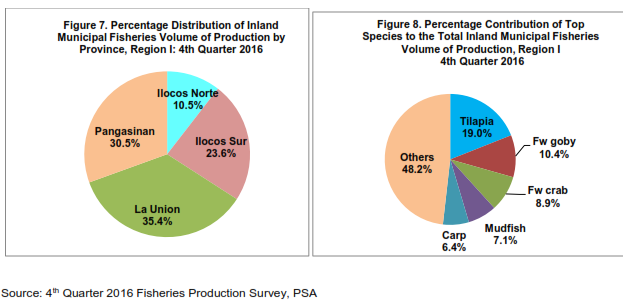
Aquaculture
Aquaculture production of Region I increased by 4.1 percent in 4th Quarter 2016. From its output of 51,263 metric tons in the same period of 2015, it went up to 53,383 metric tons in 4th quarter 2016. The provinces of Pangasinan and La Union posted increases in output. The overall positive growth in production could be attributed to proper pond and feeding management, availability of stocks, favorable water level, and increased stocking density.
Table 4. Volume of Aquaculture Production by Province, Region I: 4th Quarter 2016
and 4th quarter 2015
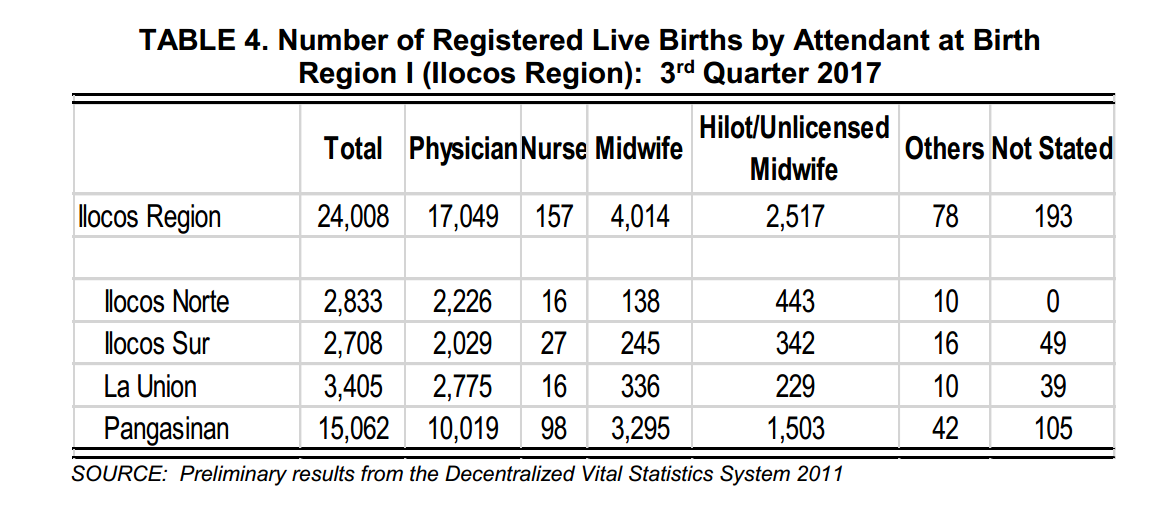
The province of Pangasinan shared the bulk of aquaculture production with 99.3 percent. By culture type, aquaculture in Region I was dominated by Marine cage which accounted for 80.7 percent of the total production.
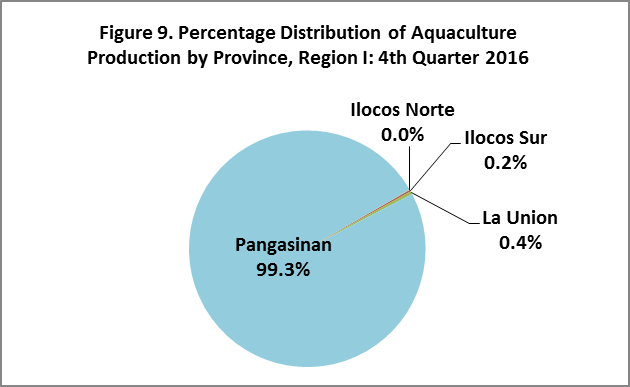
Source: 4th Quarter 2016 Fisheries Production Survey, PSA

Source: 4th Quarter 2016 Fisheries Production Survey, PSA
Milkfish dominated the aquaculture production of Region I with a share of 94.0 percent.
Its production in 4th quarter 2016 was posted at 50,171 metric tons or 4.7 percent higher than its output in the same quarter of 2015. Proper pond management and feeding, additional use of organic fertilizer such as chicken manure for the production of natural food, bigger sizes of produce, and increased stoking density were the factors that contributed to higher production.
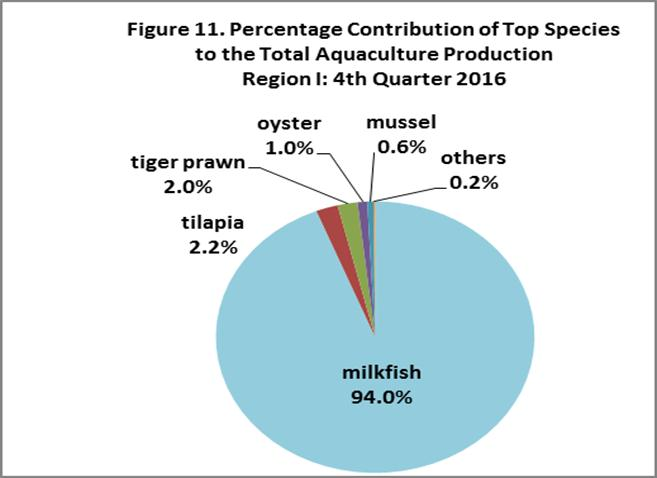
Source: 4th Quarter 2016 Fisheries Production Survey, PSA
Among the provinces of Region I, Pangasinan reported the bulk of milkfish production in 4th quarter 2016. It shared 99.6 percent to the total production of the region. The rest were shared by the other three provinces.
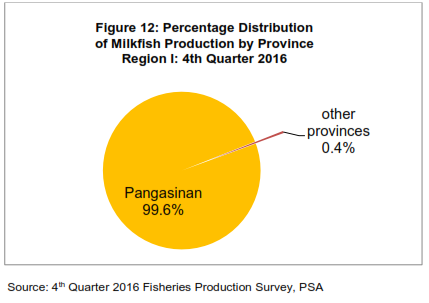
TECHNICAL NOTES
· The Fisheries Production Survey of the Philippine Statistics Authority (PSA) is divided into four (4) major fisheries surveys. These are the Quarterly Commercial Fisheries Survey (QCFS), Quarterly Municipal Fisheries Survey (QMFS), Quarterly Inland Fisheries Survey (QIFS) and Quarterly Aquaculture Survey (QAqS). The commercial and municipal fisheries surveys aim to provide quarterly data on volume and value of fish production by species, by region and by province. The aquaculture survey is intended to generate quarterly data on volume and value of cultured species by environment, by type of aquafarm, by region and by province.
· Concepts and Definitions:
Aquaculture – fishery operation involving all forms of raising and culturing of fish and other fishery species in marine, brackish and fresh water environment. Examples are fishponds, fish pens, fish cages, mussel, oyster, seaweed farms and hatcheries.
Aquafarm – the farming facilities used in the culture or propagation of aquatic species including fish, mollusk, crustaceans and aquatic plants for purposes of rearing to enhance production.
Brackishwater – mixture of seawater and freshwater with salinity that varies with the tide. Example are estuaries, mangroves and mouths of rivers where seawater enters during high tide.
Commercial Fishing – the catching of fish with the use of fishing boats with a capacity of more than three (3) gross tons for trade, business or profit beyond subsistence or sports fishing.
Fisheries – all activities relating to the act or business of fishing, culturing, preserving, processing, marketing, developing, conserving and managing aquatic resources and the fishery areas including the privilege to fish or take aquatic resources thereof (RA 8550).
Fisheries Sector – the sector engaged in the production, growing, harvesting, processing, marketing, developing, conserving and managing of aquatic resources and fishing areas.
Fish Cage – stationary or floating fish enclosure made of synthetic net wire/bamboo screen or other materials set in the form of inverted mosquito net (“hapa” type) with or without cover with all sides either tied to poles staked to the water bottom or with anchored floats for aquaculture purposes.
Fishing Gear – any instrument or device and its accessories utilized in taking fish and other fishery species.
Fishing Grounds – areas in any body of water where fish and other aquatic resources congregate and become target of capture.
Fish Pen – an artificial enclosure constructed within a body of water for culturing fish and fishery/ aquatic resources made up of bamboo poles closely arranged in an enclosure with wooden materials, screen or nylon netting to prevent escape of fish.
Fishpond – a body of water (artificial or natural) where fish and other aquatic products are cultured, raised or cultivated under controlled conditions. This is a land-based type of aquafarm. Note that the setting-up of fish cages in ponds does not make the operation of fish cage and at the same time a fishpond.
Freshwater – water without salt or marine origin, such as generally found in lakes, rivers, canals, dams, reservoirs, paddy fields and swamps.
Inland Municipal Fishing – the catching of fish, crustaceans, mollusks and all other aquatic animals and plants in inland water like lakes, rivers, dams, marshes, etc. using simple gears and fishing boats some of which are non-motorized with a capacity of three (3) gross tons or less; or fishing not requiring the use of fishing boats.
Landing Center – place where the fish catch and other aquatic products are unloaded and traded.
Municipal Fishing – covers fishing operation carried out with or without the use of a boat weighing three (3) gross tons or less.

